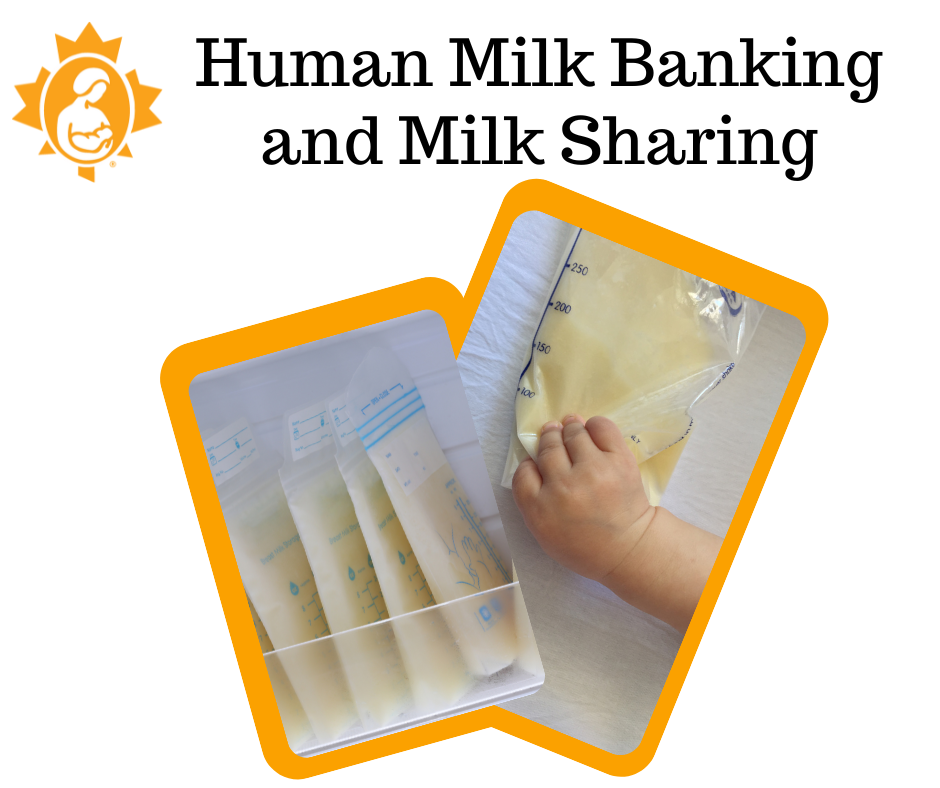
The first priority of La Leche League Canada is to help mothers nourish their babies at the breast and meet their own feeding goals. A second priority is to provide information and support when it is necessary for parents to express and safely store and handle their own milk for their babies. When a baby’s own mother’s milk is unavailable, the baby may need human milk donated by others. According to the World Health Organization, donor milk is the best option following one’s own expressed milk.
If you are in need of donated human milk, the first thing to consider is speaking with your healthcare provider about the specifics of your own situation.Parents can also contact a La Leche League Leader for information about finding donated human milk. LLLC Leaders do not recommend a specific milk bank or informal milk sharing network but they can give you information about your options. This will help you decide what is right for you and your baby.
Human Milk Banks
There are currently four licensed human milk banks in Canada operating in Calgary, Montreal, Toronto, and Vancouver.
- Calgary Mothers’ Milk Bank, Calgary, Alberta
- Public Mothers’ Milk Bank, Montreal, Quebec
- Rogers Hixon Ontario Human Milk Bank, Toronto, Ontario
- BC Women’s Provincial Milk Bank, Vancouver, British Columbia
In Canada human milk banks are not-for-profit organizations. Mothers donate their milk to help others; they are never paid for their donations. In some cases, families may receive payment to cover the costs of shipping and storage containers.
Following the guidelines created by the Human Milk Banking Association of North America (HMBANA) these milk banks abide by strict operating procedures. These include medical supervision, bacteriological testing, pasteurization, proper storage, and distribution. Due to limited supply, the donated human milk in Canadian milk banks is normally only available by prescription to babies who meet strict criteria. Milk from these banks is usually reserved for hospitalized premature babies whose mothers have not yet established an adequate milk supply by pumping. However, human milk may be available for purchase from some not-for-profit milk banks if supply allows.
Human milk banks have a rigorous screening procedure for potential donors that takes place prior to donating milk. It includes a comprehensive medical and lifestyle interview, approval from a physician and testing for several diseases. This testing is repeated on a semi-annual basis. Milk is not accepted if the donor is taking prescription drugs, has a chronic infection or smokes. The specific criteria may differ slightly from one place to another. After passing all of the strict screening procedures, donors are educated on safe handling and storage techniques. The expressed milk is frozen, stored and transported to the milk bank for further processing. For more information on the safety criteria for human milk donors, please see the websites for the various milk banks above and go to the tab on how to become a donor.
When donor human milk (DHM) reaches the milk bank, it is thawed, cultured to determine the bacterial content and then mixed with other donor milk. This donor milk is then pasteurized using the Holder method (62.5°C for 30 minutes). This achieves the microbiological safe level required for other commercial liquid milk sold in Canada. After pasteurization, another microbial screening is performed to ensure the absence of all microorganisms. The milk is then frozen and stored.
Informal Milk Sharing
La Leche League does not help arrange informal milk sharing between mothers. La Leche League’s role is to provide information about the risks and benefits of informal milk sharing so that parents can make informed decisions about what is best for their families.
The benefits of donor human milk include, but are not limited to: optimal nutrition, easy digestibility, and immunologic protection.
Risks of unregulated donor human milk can include transmission of bacteria or viruses. These have been found in milk expressed by women who are showing no signs of illness. Prescription and non-prescription drugs and environmental contaminants can be present in human milk. There is potential for unhygienic handling and improper storage of unprocessed donated milk. In a study of donor human milk purchased from ads found on the internet, some samples were found to have been extended with cow’s milk to increase the volume.
Babies of different ages require a specific composition of milk. Milk from the baby's own mother will provide the exact make-up the infant needs; another mother whose baby is not the same age may not provide the same components in the same ratios.
If you are interested in donating or acquiring human milk informally, Eats on Feets and Human Milk for Human Babies are organizations that provides valuable information for how to do this safely. Through area networks, people looking for milk or looking to offer milk can get connected. It is important that you be well informed before entering into a milk sharing relationship.
La Leche League Canada Leaders are happy to help parents in any situation work out their best options for providing human milk for their babies.
Please consider supporting LLLC.
References:
HMBANA, (2020, September). Standards for Donor Human Milk Banking: An Overview. Fort Worth, TX: Human Milk Banking Association of North America, Inc.
Health Canada. (2014, May 20). Safety of Donor Human Milk in Canada. canada.ca
Updated 2024
